Comprehensive Report: Operations and Project Management at Tesco
VerifiedAdded on 2020/10/22
|21
|5982
|296
Report
AI Summary
This report provides a detailed analysis of Tesco's operations and project management practices. It begins with an introduction to Tesco, followed by a comparison of operations and operations management. The report then reviews and critiques the implementation of operations management principles, including inventory management, planning, and manufacturing. It assesses how Tesco's operational management approaches meet organizational requirements, with a focus on total quality management, Six Sigma, and lean principles. The discussion extends to continuous improvement as a philosophy, elaborating on lean principles and Kaizen. Furthermore, the report includes a continuous improvement plan and examines the project life cycle, emphasizing documentation and effectiveness using relevant theories and models. Overall, the report offers insights into Tesco's strategies for achieving efficiency and meeting its business objectives.
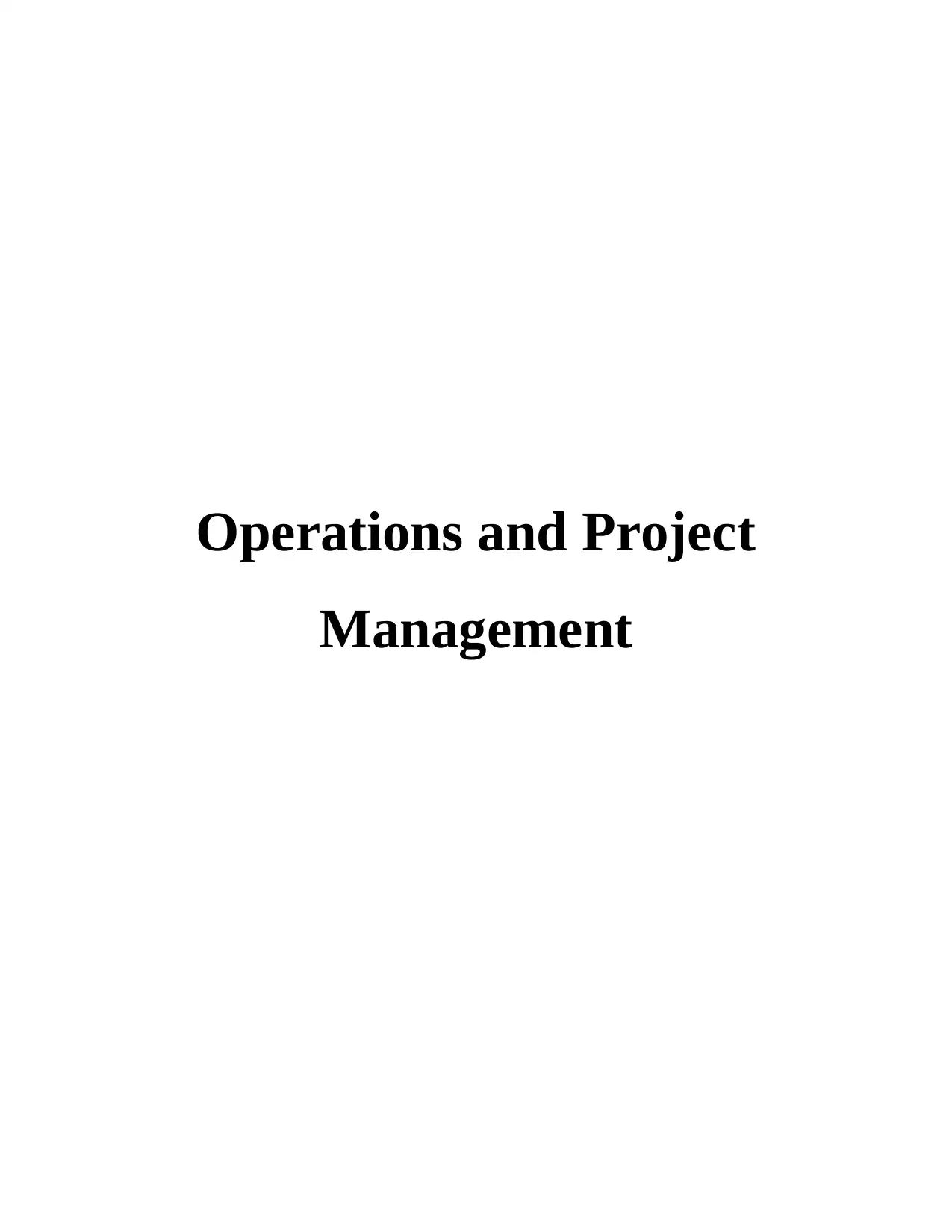
Operations and Project
Management
Management
Paraphrase This Document
Need a fresh take? Get an instant paraphrase of this document with our AI Paraphraser
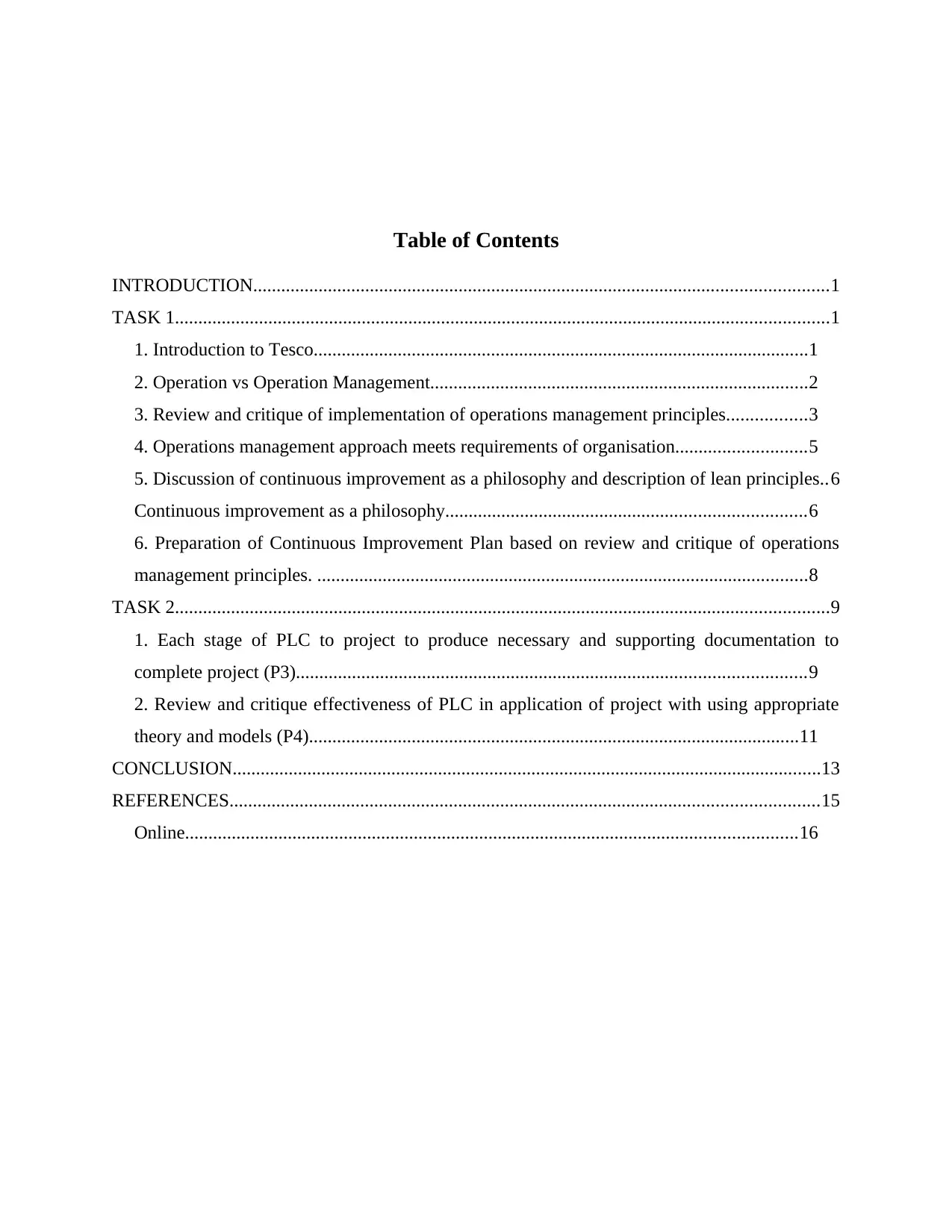
Table of Contents
INTRODUCTION...........................................................................................................................1
TASK 1............................................................................................................................................1
1. Introduction to Tesco..........................................................................................................1
2. Operation vs Operation Management.................................................................................2
3. Review and critique of implementation of operations management principles.................3
4. Operations management approach meets requirements of organisation............................5
5. Discussion of continuous improvement as a philosophy and description of lean principles..6
Continuous improvement as a philosophy.............................................................................6
6. Preparation of Continuous Improvement Plan based on review and critique of operations
management principles. .........................................................................................................8
TASK 2............................................................................................................................................9
1. Each stage of PLC to project to produce necessary and supporting documentation to
complete project (P3).............................................................................................................9
2. Review and critique effectiveness of PLC in application of project with using appropriate
theory and models (P4).........................................................................................................11
CONCLUSION..............................................................................................................................13
REFERENCES..............................................................................................................................15
Online...................................................................................................................................16
INTRODUCTION...........................................................................................................................1
TASK 1............................................................................................................................................1
1. Introduction to Tesco..........................................................................................................1
2. Operation vs Operation Management.................................................................................2
3. Review and critique of implementation of operations management principles.................3
4. Operations management approach meets requirements of organisation............................5
5. Discussion of continuous improvement as a philosophy and description of lean principles..6
Continuous improvement as a philosophy.............................................................................6
6. Preparation of Continuous Improvement Plan based on review and critique of operations
management principles. .........................................................................................................8
TASK 2............................................................................................................................................9
1. Each stage of PLC to project to produce necessary and supporting documentation to
complete project (P3).............................................................................................................9
2. Review and critique effectiveness of PLC in application of project with using appropriate
theory and models (P4).........................................................................................................11
CONCLUSION..............................................................................................................................13
REFERENCES..............................................................................................................................15
Online...................................................................................................................................16
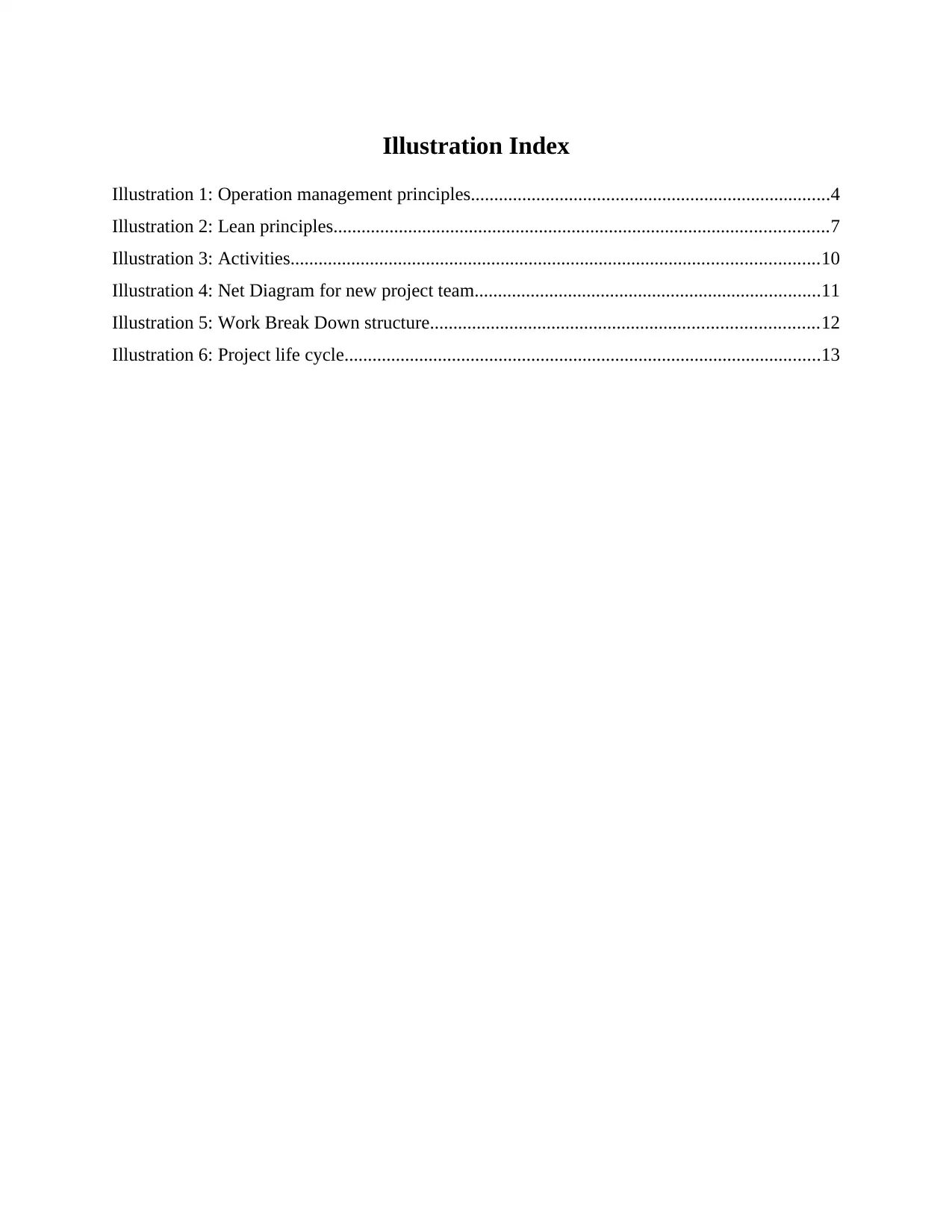
Illustration Index
Illustration 1: Operation management principles.............................................................................4
Illustration 2: Lean principles..........................................................................................................7
Illustration 3: Activities.................................................................................................................10
Illustration 4: Net Diagram for new project team..........................................................................11
Illustration 5: Work Break Down structure...................................................................................12
Illustration 6: Project life cycle......................................................................................................13
Illustration 1: Operation management principles.............................................................................4
Illustration 2: Lean principles..........................................................................................................7
Illustration 3: Activities.................................................................................................................10
Illustration 4: Net Diagram for new project team..........................................................................11
Illustration 5: Work Break Down structure...................................................................................12
Illustration 6: Project life cycle......................................................................................................13
⊘ This is a preview!⊘
Do you want full access?
Subscribe today to unlock all pages.

Trusted by 1+ million students worldwide
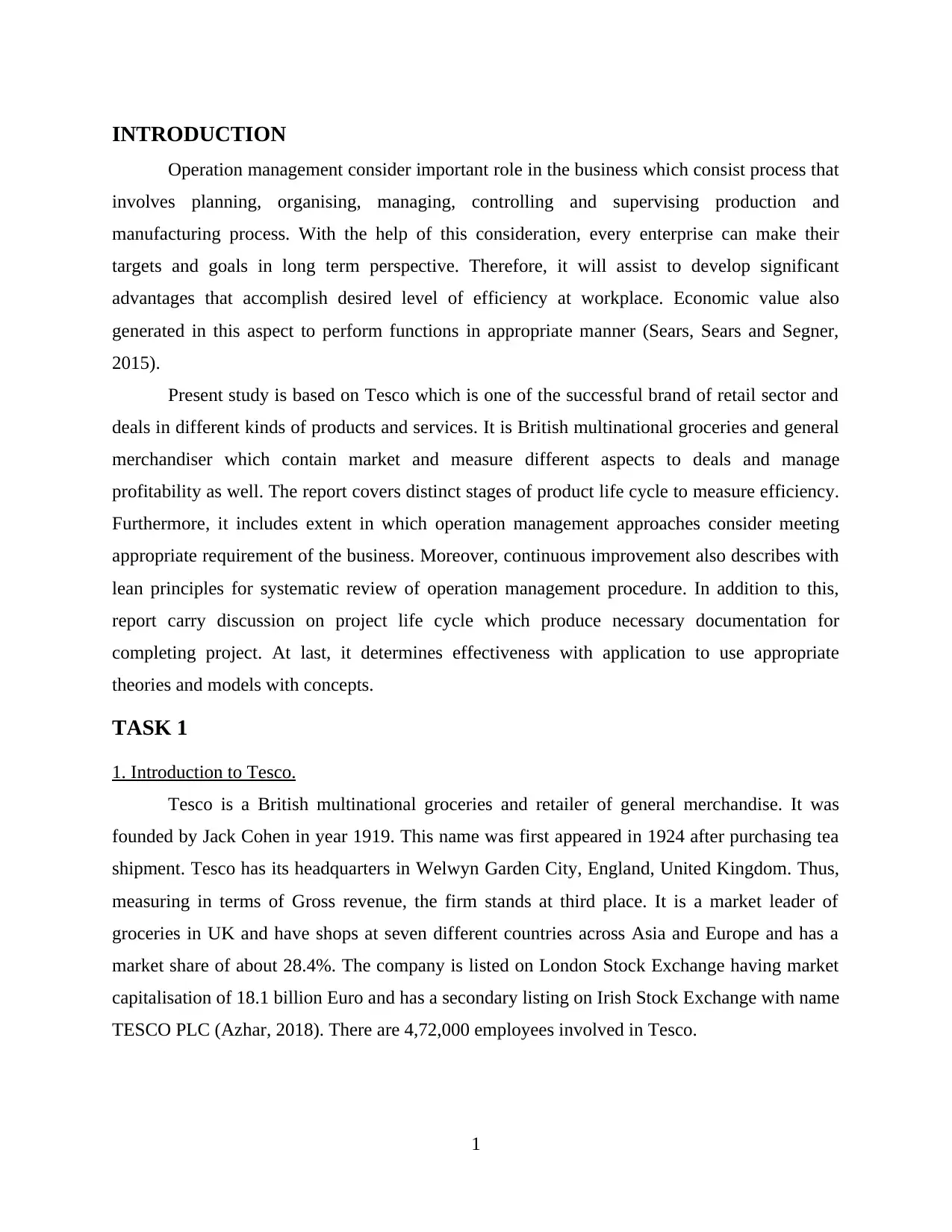
INTRODUCTION
Operation management consider important role in the business which consist process that
involves planning, organising, managing, controlling and supervising production and
manufacturing process. With the help of this consideration, every enterprise can make their
targets and goals in long term perspective. Therefore, it will assist to develop significant
advantages that accomplish desired level of efficiency at workplace. Economic value also
generated in this aspect to perform functions in appropriate manner (Sears, Sears and Segner,
2015).
Present study is based on Tesco which is one of the successful brand of retail sector and
deals in different kinds of products and services. It is British multinational groceries and general
merchandiser which contain market and measure different aspects to deals and manage
profitability as well. The report covers distinct stages of product life cycle to measure efficiency.
Furthermore, it includes extent in which operation management approaches consider meeting
appropriate requirement of the business. Moreover, continuous improvement also describes with
lean principles for systematic review of operation management procedure. In addition to this,
report carry discussion on project life cycle which produce necessary documentation for
completing project. At last, it determines effectiveness with application to use appropriate
theories and models with concepts.
TASK 1
1. Introduction to Tesco.
Tesco is a British multinational groceries and retailer of general merchandise. It was
founded by Jack Cohen in year 1919. This name was first appeared in 1924 after purchasing tea
shipment. Tesco has its headquarters in Welwyn Garden City, England, United Kingdom. Thus,
measuring in terms of Gross revenue, the firm stands at third place. It is a market leader of
groceries in UK and have shops at seven different countries across Asia and Europe and has a
market share of about 28.4%. The company is listed on London Stock Exchange having market
capitalisation of 18.1 billion Euro and has a secondary listing on Irish Stock Exchange with name
TESCO PLC (Azhar, 2018). There are 4,72,000 employees involved in Tesco.
1
Operation management consider important role in the business which consist process that
involves planning, organising, managing, controlling and supervising production and
manufacturing process. With the help of this consideration, every enterprise can make their
targets and goals in long term perspective. Therefore, it will assist to develop significant
advantages that accomplish desired level of efficiency at workplace. Economic value also
generated in this aspect to perform functions in appropriate manner (Sears, Sears and Segner,
2015).
Present study is based on Tesco which is one of the successful brand of retail sector and
deals in different kinds of products and services. It is British multinational groceries and general
merchandiser which contain market and measure different aspects to deals and manage
profitability as well. The report covers distinct stages of product life cycle to measure efficiency.
Furthermore, it includes extent in which operation management approaches consider meeting
appropriate requirement of the business. Moreover, continuous improvement also describes with
lean principles for systematic review of operation management procedure. In addition to this,
report carry discussion on project life cycle which produce necessary documentation for
completing project. At last, it determines effectiveness with application to use appropriate
theories and models with concepts.
TASK 1
1. Introduction to Tesco.
Tesco is a British multinational groceries and retailer of general merchandise. It was
founded by Jack Cohen in year 1919. This name was first appeared in 1924 after purchasing tea
shipment. Tesco has its headquarters in Welwyn Garden City, England, United Kingdom. Thus,
measuring in terms of Gross revenue, the firm stands at third place. It is a market leader of
groceries in UK and have shops at seven different countries across Asia and Europe and has a
market share of about 28.4%. The company is listed on London Stock Exchange having market
capitalisation of 18.1 billion Euro and has a secondary listing on Irish Stock Exchange with name
TESCO PLC (Azhar, 2018). There are 4,72,000 employees involved in Tesco.
1
Paraphrase This Document
Need a fresh take? Get an instant paraphrase of this document with our AI Paraphraser
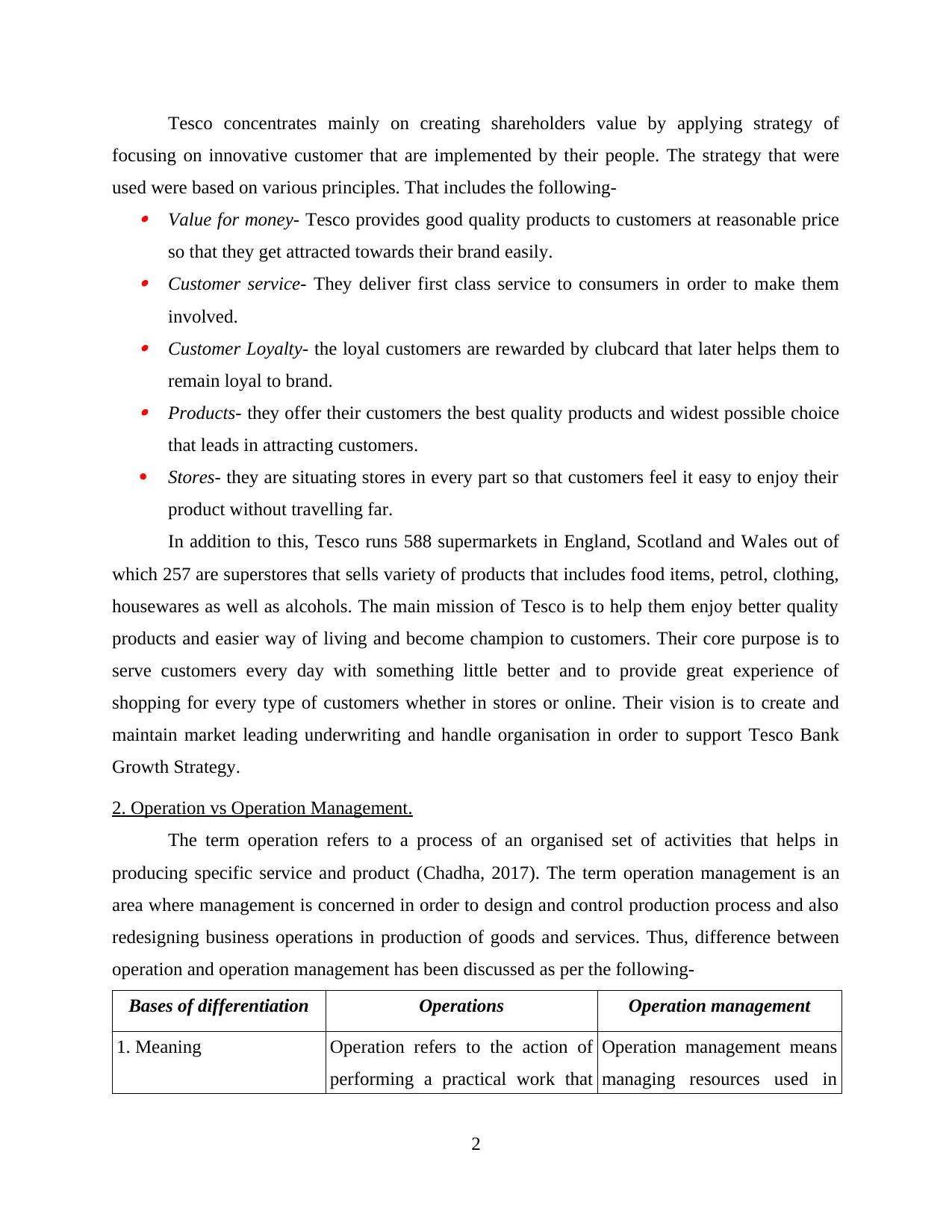
Tesco concentrates mainly on creating shareholders value by applying strategy of
focusing on innovative customer that are implemented by their people. The strategy that were
used were based on various principles. That includes the following- Value for money- Tesco provides good quality products to customers at reasonable price
so that they get attracted towards their brand easily. Customer service- They deliver first class service to consumers in order to make them
involved. Customer Loyalty- the loyal customers are rewarded by clubcard that later helps them to
remain loyal to brand. Products- they offer their customers the best quality products and widest possible choice
that leads in attracting customers.
Stores- they are situating stores in every part so that customers feel it easy to enjoy their
product without travelling far.
In addition to this, Tesco runs 588 supermarkets in England, Scotland and Wales out of
which 257 are superstores that sells variety of products that includes food items, petrol, clothing,
housewares as well as alcohols. The main mission of Tesco is to help them enjoy better quality
products and easier way of living and become champion to customers. Their core purpose is to
serve customers every day with something little better and to provide great experience of
shopping for every type of customers whether in stores or online. Their vision is to create and
maintain market leading underwriting and handle organisation in order to support Tesco Bank
Growth Strategy.
2. Operation vs Operation Management.
The term operation refers to a process of an organised set of activities that helps in
producing specific service and product (Chadha, 2017). The term operation management is an
area where management is concerned in order to design and control production process and also
redesigning business operations in production of goods and services. Thus, difference between
operation and operation management has been discussed as per the following-
Bases of differentiation Operations Operation management
1. Meaning Operation refers to the action of
performing a practical work that
Operation management means
managing resources used in
2
focusing on innovative customer that are implemented by their people. The strategy that were
used were based on various principles. That includes the following- Value for money- Tesco provides good quality products to customers at reasonable price
so that they get attracted towards their brand easily. Customer service- They deliver first class service to consumers in order to make them
involved. Customer Loyalty- the loyal customers are rewarded by clubcard that later helps them to
remain loyal to brand. Products- they offer their customers the best quality products and widest possible choice
that leads in attracting customers.
Stores- they are situating stores in every part so that customers feel it easy to enjoy their
product without travelling far.
In addition to this, Tesco runs 588 supermarkets in England, Scotland and Wales out of
which 257 are superstores that sells variety of products that includes food items, petrol, clothing,
housewares as well as alcohols. The main mission of Tesco is to help them enjoy better quality
products and easier way of living and become champion to customers. Their core purpose is to
serve customers every day with something little better and to provide great experience of
shopping for every type of customers whether in stores or online. Their vision is to create and
maintain market leading underwriting and handle organisation in order to support Tesco Bank
Growth Strategy.
2. Operation vs Operation Management.
The term operation refers to a process of an organised set of activities that helps in
producing specific service and product (Chadha, 2017). The term operation management is an
area where management is concerned in order to design and control production process and also
redesigning business operations in production of goods and services. Thus, difference between
operation and operation management has been discussed as per the following-
Bases of differentiation Operations Operation management
1. Meaning Operation refers to the action of
performing a practical work that
Operation management means
managing resources used in
2
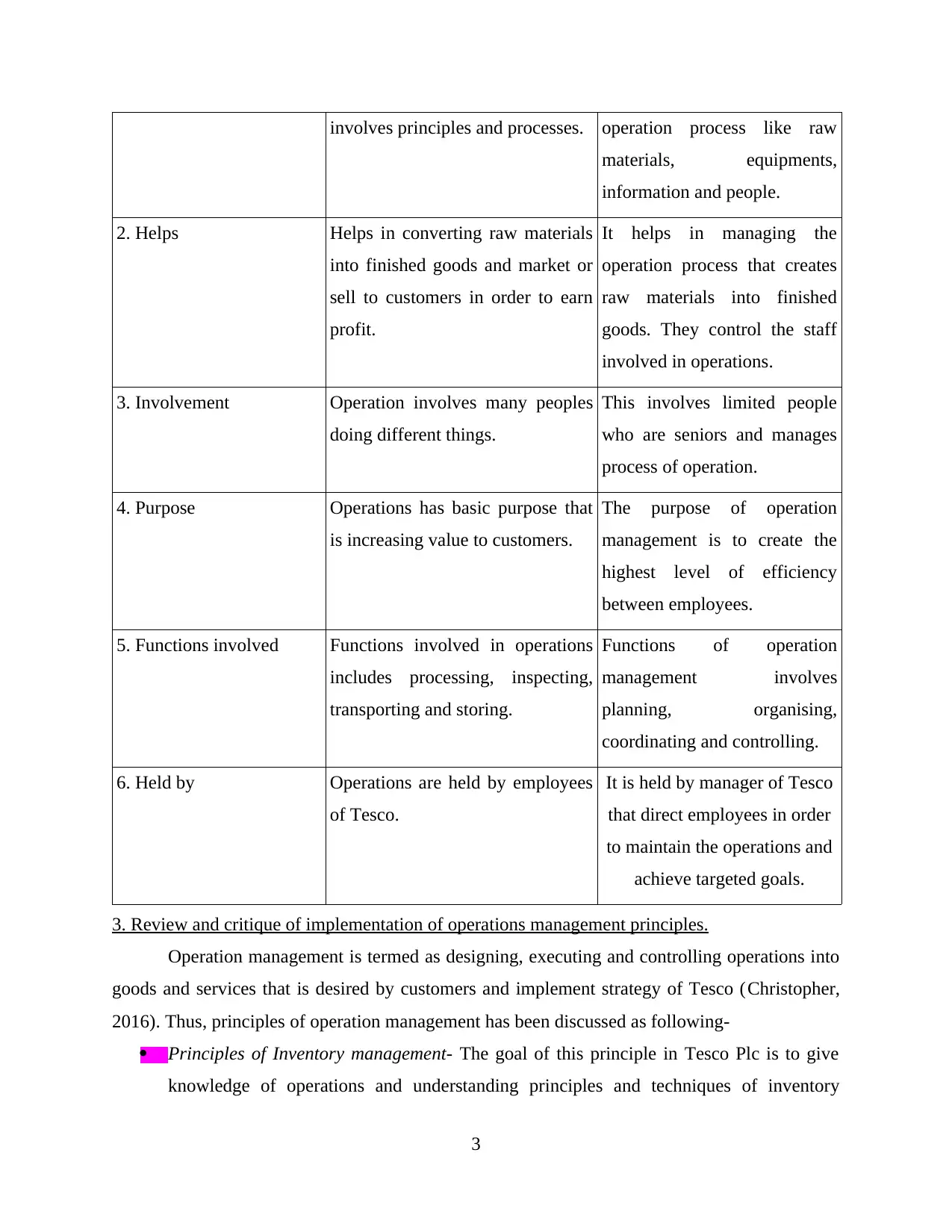
involves principles and processes. operation process like raw
materials, equipments,
information and people.
2. Helps Helps in converting raw materials
into finished goods and market or
sell to customers in order to earn
profit.
It helps in managing the
operation process that creates
raw materials into finished
goods. They control the staff
involved in operations.
3. Involvement Operation involves many peoples
doing different things.
This involves limited people
who are seniors and manages
process of operation.
4. Purpose Operations has basic purpose that
is increasing value to customers.
The purpose of operation
management is to create the
highest level of efficiency
between employees.
5. Functions involved Functions involved in operations
includes processing, inspecting,
transporting and storing.
Functions of operation
management involves
planning, organising,
coordinating and controlling.
6. Held by Operations are held by employees
of Tesco.
It is held by manager of Tesco
that direct employees in order
to maintain the operations and
achieve targeted goals.
3. Review and critique of implementation of operations management principles.
Operation management is termed as designing, executing and controlling operations into
goods and services that is desired by customers and implement strategy of Tesco (Christopher,
2016). Thus, principles of operation management has been discussed as following-
Principles of Inventory management- The goal of this principle in Tesco Plc is to give
knowledge of operations and understanding principles and techniques of inventory
3
materials, equipments,
information and people.
2. Helps Helps in converting raw materials
into finished goods and market or
sell to customers in order to earn
profit.
It helps in managing the
operation process that creates
raw materials into finished
goods. They control the staff
involved in operations.
3. Involvement Operation involves many peoples
doing different things.
This involves limited people
who are seniors and manages
process of operation.
4. Purpose Operations has basic purpose that
is increasing value to customers.
The purpose of operation
management is to create the
highest level of efficiency
between employees.
5. Functions involved Functions involved in operations
includes processing, inspecting,
transporting and storing.
Functions of operation
management involves
planning, organising,
coordinating and controlling.
6. Held by Operations are held by employees
of Tesco.
It is held by manager of Tesco
that direct employees in order
to maintain the operations and
achieve targeted goals.
3. Review and critique of implementation of operations management principles.
Operation management is termed as designing, executing and controlling operations into
goods and services that is desired by customers and implement strategy of Tesco (Christopher,
2016). Thus, principles of operation management has been discussed as following-
Principles of Inventory management- The goal of this principle in Tesco Plc is to give
knowledge of operations and understanding principles and techniques of inventory
3
⊘ This is a preview!⊘
Do you want full access?
Subscribe today to unlock all pages.

Trusted by 1+ million students worldwide
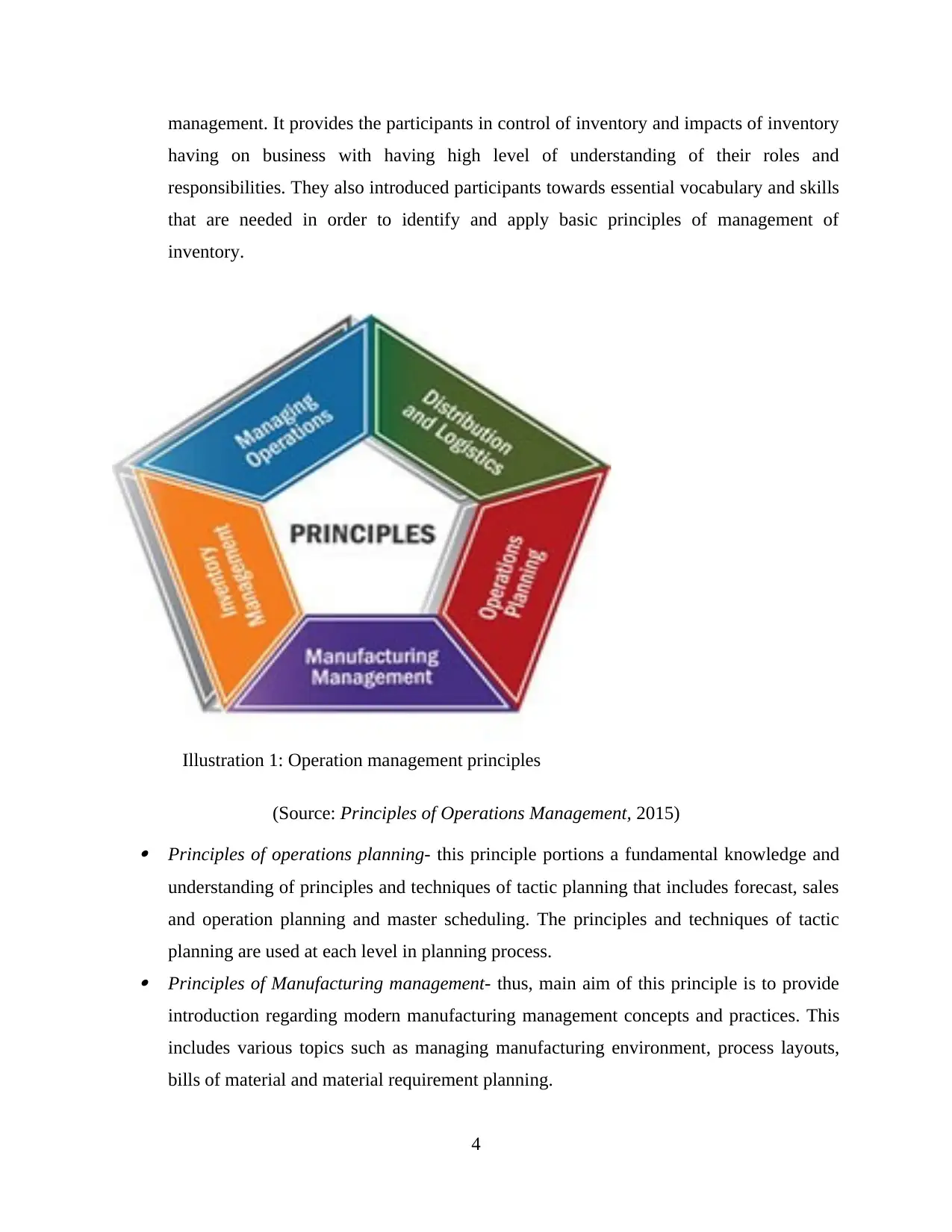
management. It provides the participants in control of inventory and impacts of inventory
having on business with having high level of understanding of their roles and
responsibilities. They also introduced participants towards essential vocabulary and skills
that are needed in order to identify and apply basic principles of management of
inventory.
Illustration 1: Operation management principles
(Source: Principles of Operations Management, 2015) Principles of operations planning- this principle portions a fundamental knowledge and
understanding of principles and techniques of tactic planning that includes forecast, sales
and operation planning and master scheduling. The principles and techniques of tactic
planning are used at each level in planning process. Principles of Manufacturing management- thus, main aim of this principle is to provide
introduction regarding modern manufacturing management concepts and practices. This
includes various topics such as managing manufacturing environment, process layouts,
bills of material and material requirement planning.
4
having on business with having high level of understanding of their roles and
responsibilities. They also introduced participants towards essential vocabulary and skills
that are needed in order to identify and apply basic principles of management of
inventory.
Illustration 1: Operation management principles
(Source: Principles of Operations Management, 2015) Principles of operations planning- this principle portions a fundamental knowledge and
understanding of principles and techniques of tactic planning that includes forecast, sales
and operation planning and master scheduling. The principles and techniques of tactic
planning are used at each level in planning process. Principles of Manufacturing management- thus, main aim of this principle is to provide
introduction regarding modern manufacturing management concepts and practices. This
includes various topics such as managing manufacturing environment, process layouts,
bills of material and material requirement planning.
4
Paraphrase This Document
Need a fresh take? Get an instant paraphrase of this document with our AI Paraphraser
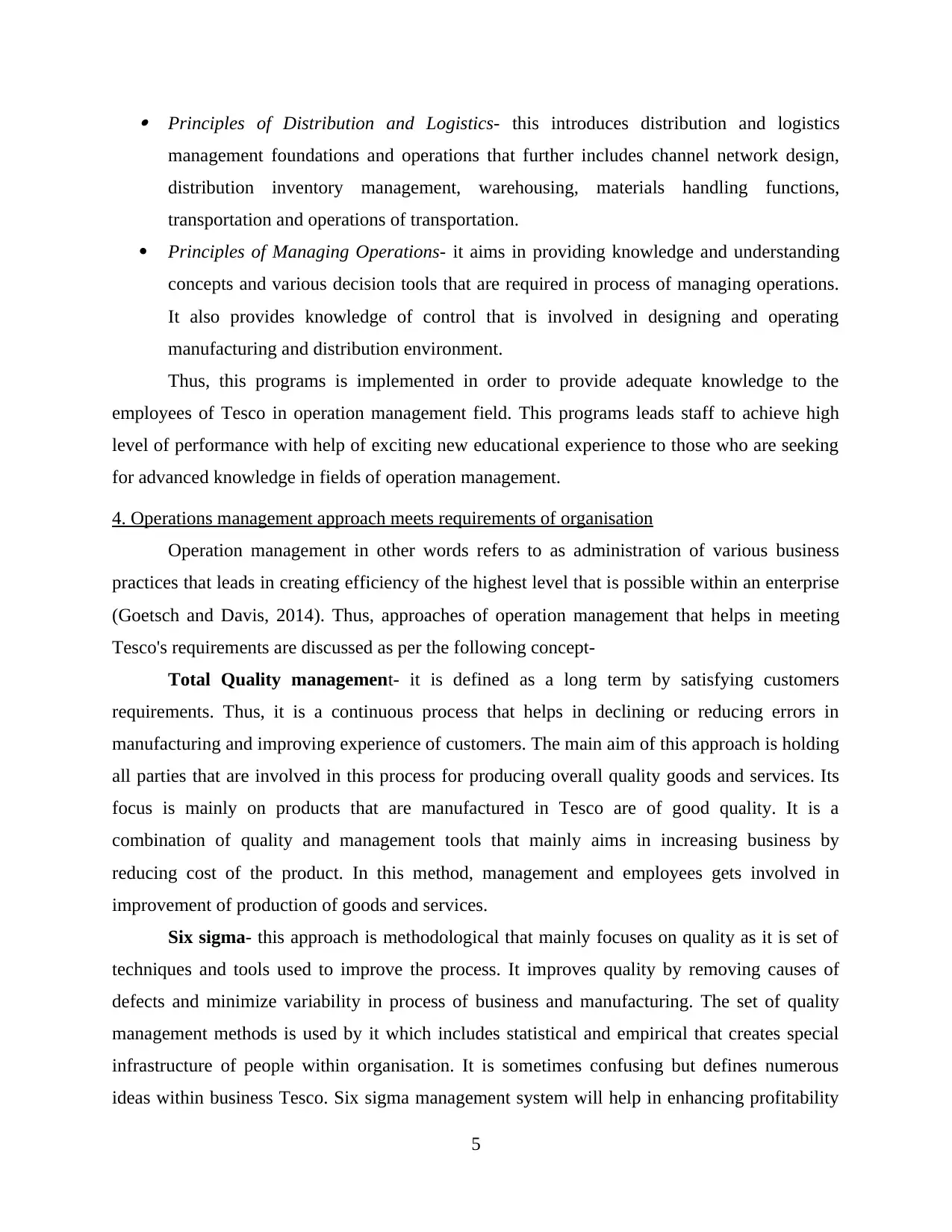
Principles of Distribution and Logistics- this introduces distribution and logistics
management foundations and operations that further includes channel network design,
distribution inventory management, warehousing, materials handling functions,
transportation and operations of transportation.
Principles of Managing Operations- it aims in providing knowledge and understanding
concepts and various decision tools that are required in process of managing operations.
It also provides knowledge of control that is involved in designing and operating
manufacturing and distribution environment.
Thus, this programs is implemented in order to provide adequate knowledge to the
employees of Tesco in operation management field. This programs leads staff to achieve high
level of performance with help of exciting new educational experience to those who are seeking
for advanced knowledge in fields of operation management.
4. Operations management approach meets requirements of organisation
Operation management in other words refers to as administration of various business
practices that leads in creating efficiency of the highest level that is possible within an enterprise
(Goetsch and Davis, 2014). Thus, approaches of operation management that helps in meeting
Tesco's requirements are discussed as per the following concept-
Total Quality management- it is defined as a long term by satisfying customers
requirements. Thus, it is a continuous process that helps in declining or reducing errors in
manufacturing and improving experience of customers. The main aim of this approach is holding
all parties that are involved in this process for producing overall quality goods and services. Its
focus is mainly on products that are manufactured in Tesco are of good quality. It is a
combination of quality and management tools that mainly aims in increasing business by
reducing cost of the product. In this method, management and employees gets involved in
improvement of production of goods and services.
Six sigma- this approach is methodological that mainly focuses on quality as it is set of
techniques and tools used to improve the process. It improves quality by removing causes of
defects and minimize variability in process of business and manufacturing. The set of quality
management methods is used by it which includes statistical and empirical that creates special
infrastructure of people within organisation. It is sometimes confusing but defines numerous
ideas within business Tesco. Six sigma management system will help in enhancing profitability
5
management foundations and operations that further includes channel network design,
distribution inventory management, warehousing, materials handling functions,
transportation and operations of transportation.
Principles of Managing Operations- it aims in providing knowledge and understanding
concepts and various decision tools that are required in process of managing operations.
It also provides knowledge of control that is involved in designing and operating
manufacturing and distribution environment.
Thus, this programs is implemented in order to provide adequate knowledge to the
employees of Tesco in operation management field. This programs leads staff to achieve high
level of performance with help of exciting new educational experience to those who are seeking
for advanced knowledge in fields of operation management.
4. Operations management approach meets requirements of organisation
Operation management in other words refers to as administration of various business
practices that leads in creating efficiency of the highest level that is possible within an enterprise
(Goetsch and Davis, 2014). Thus, approaches of operation management that helps in meeting
Tesco's requirements are discussed as per the following concept-
Total Quality management- it is defined as a long term by satisfying customers
requirements. Thus, it is a continuous process that helps in declining or reducing errors in
manufacturing and improving experience of customers. The main aim of this approach is holding
all parties that are involved in this process for producing overall quality goods and services. Its
focus is mainly on products that are manufactured in Tesco are of good quality. It is a
combination of quality and management tools that mainly aims in increasing business by
reducing cost of the product. In this method, management and employees gets involved in
improvement of production of goods and services.
Six sigma- this approach is methodological that mainly focuses on quality as it is set of
techniques and tools used to improve the process. It improves quality by removing causes of
defects and minimize variability in process of business and manufacturing. The set of quality
management methods is used by it which includes statistical and empirical that creates special
infrastructure of people within organisation. It is sometimes confusing but defines numerous
ideas within business Tesco. Six sigma management system will help in enhancing profitability
5
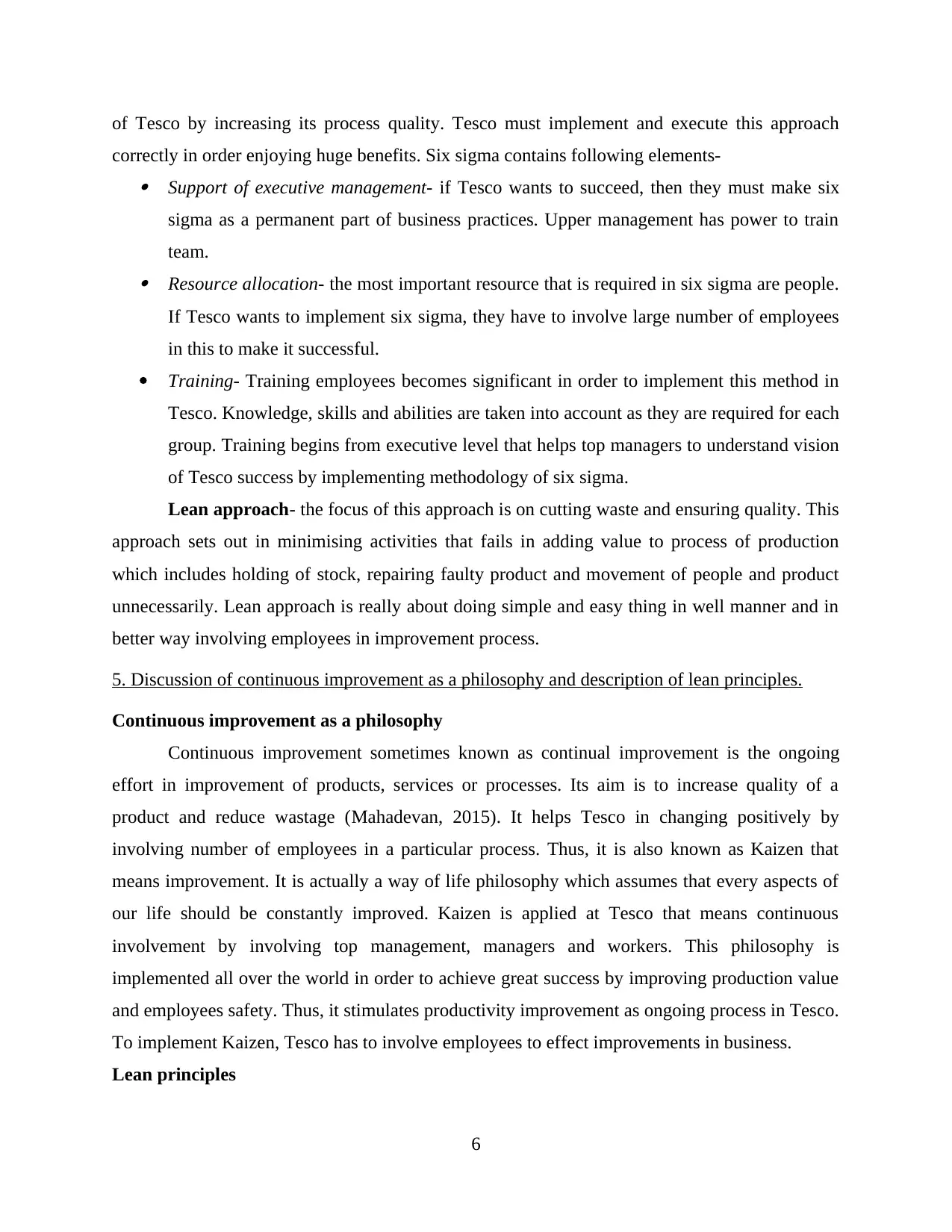
of Tesco by increasing its process quality. Tesco must implement and execute this approach
correctly in order enjoying huge benefits. Six sigma contains following elements- Support of executive management- if Tesco wants to succeed, then they must make six
sigma as a permanent part of business practices. Upper management has power to train
team. Resource allocation- the most important resource that is required in six sigma are people.
If Tesco wants to implement six sigma, they have to involve large number of employees
in this to make it successful.
Training- Training employees becomes significant in order to implement this method in
Tesco. Knowledge, skills and abilities are taken into account as they are required for each
group. Training begins from executive level that helps top managers to understand vision
of Tesco success by implementing methodology of six sigma.
Lean approach- the focus of this approach is on cutting waste and ensuring quality. This
approach sets out in minimising activities that fails in adding value to process of production
which includes holding of stock, repairing faulty product and movement of people and product
unnecessarily. Lean approach is really about doing simple and easy thing in well manner and in
better way involving employees in improvement process.
5. Discussion of continuous improvement as a philosophy and description of lean principles.
Continuous improvement as a philosophy
Continuous improvement sometimes known as continual improvement is the ongoing
effort in improvement of products, services or processes. Its aim is to increase quality of a
product and reduce wastage (Mahadevan, 2015). It helps Tesco in changing positively by
involving number of employees in a particular process. Thus, it is also known as Kaizen that
means improvement. It is actually a way of life philosophy which assumes that every aspects of
our life should be constantly improved. Kaizen is applied at Tesco that means continuous
involvement by involving top management, managers and workers. This philosophy is
implemented all over the world in order to achieve great success by improving production value
and employees safety. Thus, it stimulates productivity improvement as ongoing process in Tesco.
To implement Kaizen, Tesco has to involve employees to effect improvements in business.
Lean principles
6
correctly in order enjoying huge benefits. Six sigma contains following elements- Support of executive management- if Tesco wants to succeed, then they must make six
sigma as a permanent part of business practices. Upper management has power to train
team. Resource allocation- the most important resource that is required in six sigma are people.
If Tesco wants to implement six sigma, they have to involve large number of employees
in this to make it successful.
Training- Training employees becomes significant in order to implement this method in
Tesco. Knowledge, skills and abilities are taken into account as they are required for each
group. Training begins from executive level that helps top managers to understand vision
of Tesco success by implementing methodology of six sigma.
Lean approach- the focus of this approach is on cutting waste and ensuring quality. This
approach sets out in minimising activities that fails in adding value to process of production
which includes holding of stock, repairing faulty product and movement of people and product
unnecessarily. Lean approach is really about doing simple and easy thing in well manner and in
better way involving employees in improvement process.
5. Discussion of continuous improvement as a philosophy and description of lean principles.
Continuous improvement as a philosophy
Continuous improvement sometimes known as continual improvement is the ongoing
effort in improvement of products, services or processes. Its aim is to increase quality of a
product and reduce wastage (Mahadevan, 2015). It helps Tesco in changing positively by
involving number of employees in a particular process. Thus, it is also known as Kaizen that
means improvement. It is actually a way of life philosophy which assumes that every aspects of
our life should be constantly improved. Kaizen is applied at Tesco that means continuous
involvement by involving top management, managers and workers. This philosophy is
implemented all over the world in order to achieve great success by improving production value
and employees safety. Thus, it stimulates productivity improvement as ongoing process in Tesco.
To implement Kaizen, Tesco has to involve employees to effect improvements in business.
Lean principles
6
⊘ This is a preview!⊘
Do you want full access?
Subscribe today to unlock all pages.

Trusted by 1+ million students worldwide
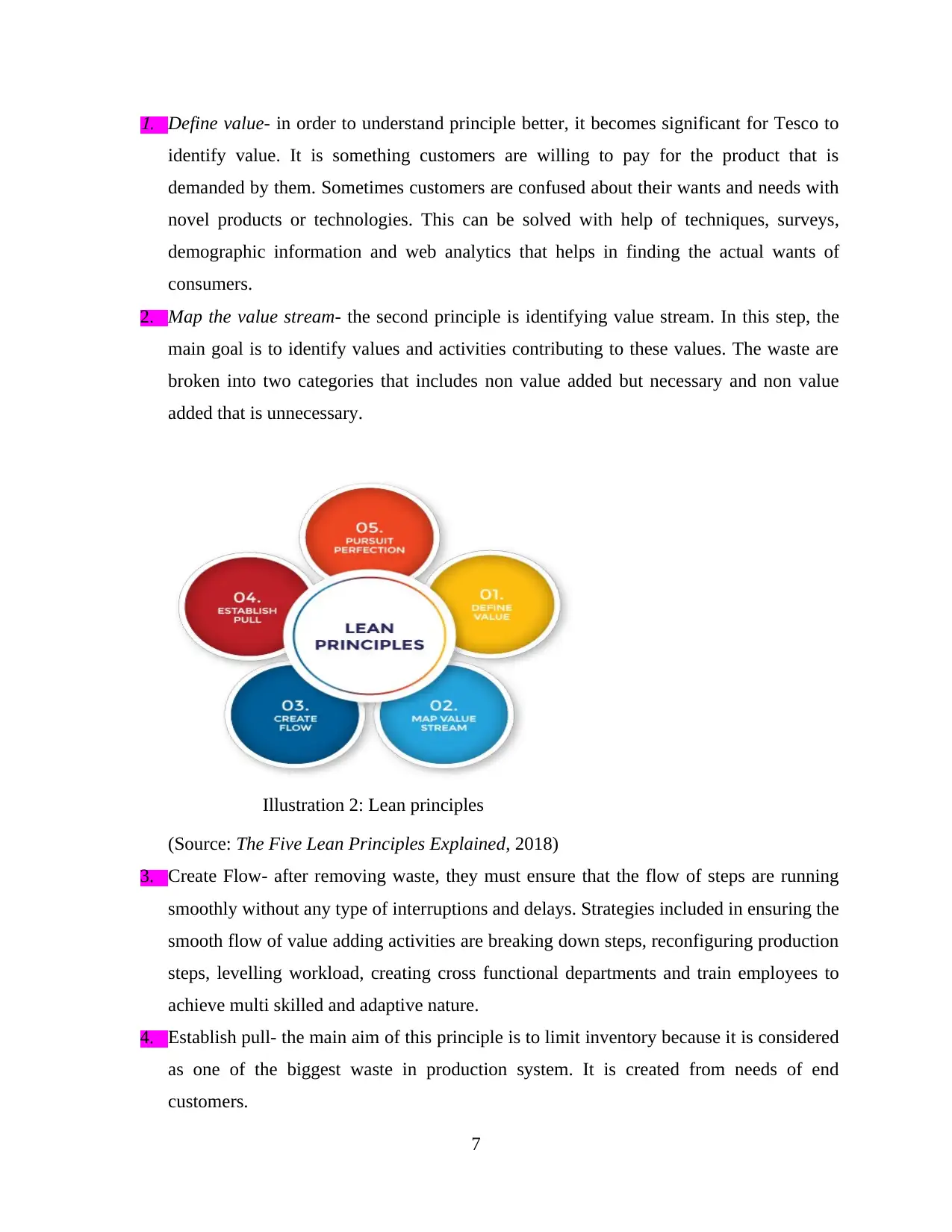
1. Define value- in order to understand principle better, it becomes significant for Tesco to
identify value. It is something customers are willing to pay for the product that is
demanded by them. Sometimes customers are confused about their wants and needs with
novel products or technologies. This can be solved with help of techniques, surveys,
demographic information and web analytics that helps in finding the actual wants of
consumers.
2. Map the value stream- the second principle is identifying value stream. In this step, the
main goal is to identify values and activities contributing to these values. The waste are
broken into two categories that includes non value added but necessary and non value
added that is unnecessary.
Illustration 2: Lean principles
(Source: The Five Lean Principles Explained, 2018)
3. Create Flow- after removing waste, they must ensure that the flow of steps are running
smoothly without any type of interruptions and delays. Strategies included in ensuring the
smooth flow of value adding activities are breaking down steps, reconfiguring production
steps, levelling workload, creating cross functional departments and train employees to
achieve multi skilled and adaptive nature.
4. Establish pull- the main aim of this principle is to limit inventory because it is considered
as one of the biggest waste in production system. It is created from needs of end
customers.
7
identify value. It is something customers are willing to pay for the product that is
demanded by them. Sometimes customers are confused about their wants and needs with
novel products or technologies. This can be solved with help of techniques, surveys,
demographic information and web analytics that helps in finding the actual wants of
consumers.
2. Map the value stream- the second principle is identifying value stream. In this step, the
main goal is to identify values and activities contributing to these values. The waste are
broken into two categories that includes non value added but necessary and non value
added that is unnecessary.
Illustration 2: Lean principles
(Source: The Five Lean Principles Explained, 2018)
3. Create Flow- after removing waste, they must ensure that the flow of steps are running
smoothly without any type of interruptions and delays. Strategies included in ensuring the
smooth flow of value adding activities are breaking down steps, reconfiguring production
steps, levelling workload, creating cross functional departments and train employees to
achieve multi skilled and adaptive nature.
4. Establish pull- the main aim of this principle is to limit inventory because it is considered
as one of the biggest waste in production system. It is created from needs of end
customers.
7
Paraphrase This Document
Need a fresh take? Get an instant paraphrase of this document with our AI Paraphraser
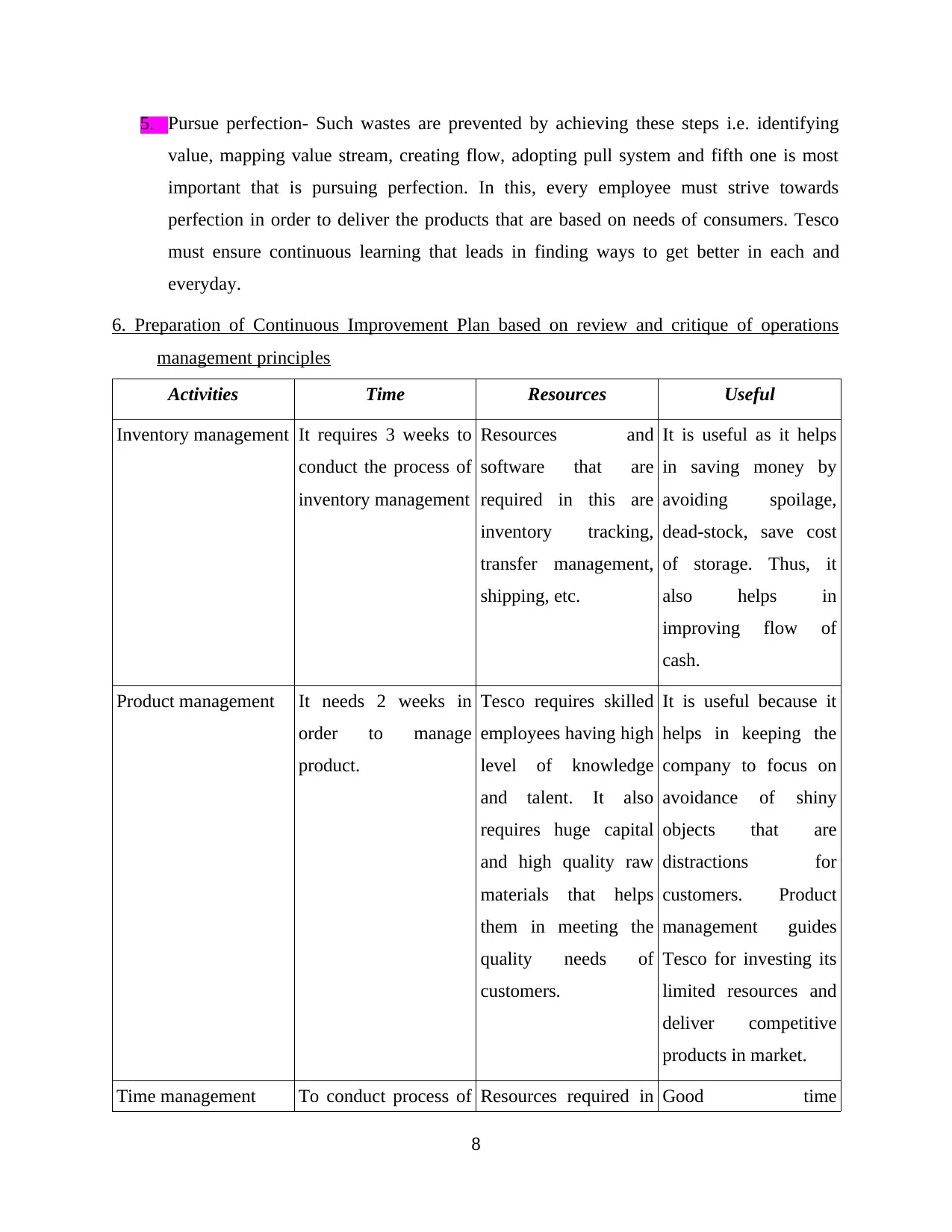
5. Pursue perfection- Such wastes are prevented by achieving these steps i.e. identifying
value, mapping value stream, creating flow, adopting pull system and fifth one is most
important that is pursuing perfection. In this, every employee must strive towards
perfection in order to deliver the products that are based on needs of consumers. Tesco
must ensure continuous learning that leads in finding ways to get better in each and
everyday.
6. Preparation of Continuous Improvement Plan based on review and critique of operations
management principles
Activities Time Resources Useful
Inventory management It requires 3 weeks to
conduct the process of
inventory management
Resources and
software that are
required in this are
inventory tracking,
transfer management,
shipping, etc.
It is useful as it helps
in saving money by
avoiding spoilage,
dead-stock, save cost
of storage. Thus, it
also helps in
improving flow of
cash.
Product management It needs 2 weeks in
order to manage
product.
Tesco requires skilled
employees having high
level of knowledge
and talent. It also
requires huge capital
and high quality raw
materials that helps
them in meeting the
quality needs of
customers.
It is useful because it
helps in keeping the
company to focus on
avoidance of shiny
objects that are
distractions for
customers. Product
management guides
Tesco for investing its
limited resources and
deliver competitive
products in market.
Time management To conduct process of Resources required in Good time
8
value, mapping value stream, creating flow, adopting pull system and fifth one is most
important that is pursuing perfection. In this, every employee must strive towards
perfection in order to deliver the products that are based on needs of consumers. Tesco
must ensure continuous learning that leads in finding ways to get better in each and
everyday.
6. Preparation of Continuous Improvement Plan based on review and critique of operations
management principles
Activities Time Resources Useful
Inventory management It requires 3 weeks to
conduct the process of
inventory management
Resources and
software that are
required in this are
inventory tracking,
transfer management,
shipping, etc.
It is useful as it helps
in saving money by
avoiding spoilage,
dead-stock, save cost
of storage. Thus, it
also helps in
improving flow of
cash.
Product management It needs 2 weeks in
order to manage
product.
Tesco requires skilled
employees having high
level of knowledge
and talent. It also
requires huge capital
and high quality raw
materials that helps
them in meeting the
quality needs of
customers.
It is useful because it
helps in keeping the
company to focus on
avoidance of shiny
objects that are
distractions for
customers. Product
management guides
Tesco for investing its
limited resources and
deliver competitive
products in market.
Time management To conduct process of Resources required in Good time
8
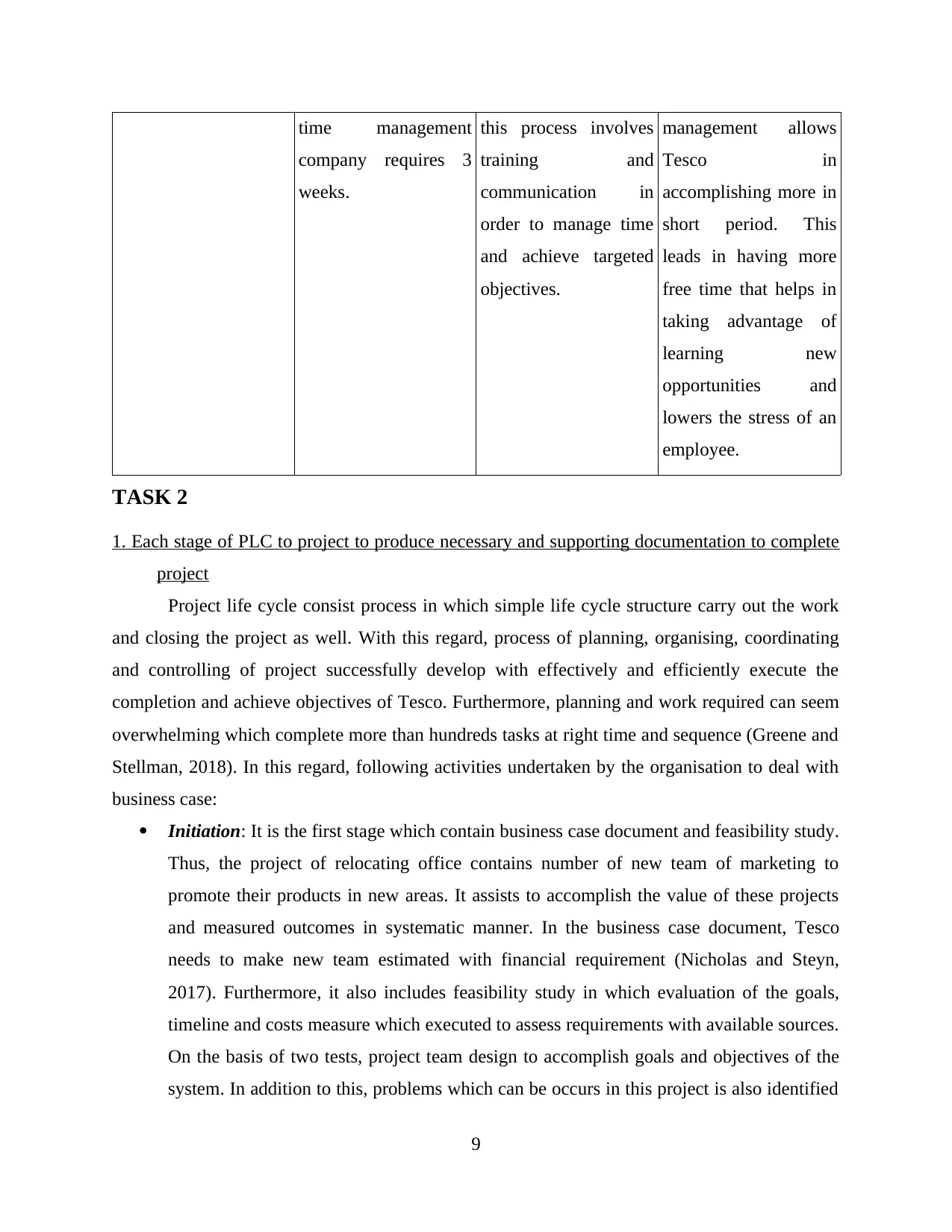
time management
company requires 3
weeks.
this process involves
training and
communication in
order to manage time
and achieve targeted
objectives.
management allows
Tesco in
accomplishing more in
short period. This
leads in having more
free time that helps in
taking advantage of
learning new
opportunities and
lowers the stress of an
employee.
TASK 2
1. Each stage of PLC to project to produce necessary and supporting documentation to complete
project
Project life cycle consist process in which simple life cycle structure carry out the work
and closing the project as well. With this regard, process of planning, organising, coordinating
and controlling of project successfully develop with effectively and efficiently execute the
completion and achieve objectives of Tesco. Furthermore, planning and work required can seem
overwhelming which complete more than hundreds tasks at right time and sequence (Greene and
Stellman, 2018). In this regard, following activities undertaken by the organisation to deal with
business case:
Initiation: It is the first stage which contain business case document and feasibility study.
Thus, the project of relocating office contains number of new team of marketing to
promote their products in new areas. It assists to accomplish the value of these projects
and measured outcomes in systematic manner. In the business case document, Tesco
needs to make new team estimated with financial requirement (Nicholas and Steyn,
2017). Furthermore, it also includes feasibility study in which evaluation of the goals,
timeline and costs measure which executed to assess requirements with available sources.
On the basis of two tests, project team design to accomplish goals and objectives of the
system. In addition to this, problems which can be occurs in this project is also identified
9
company requires 3
weeks.
this process involves
training and
communication in
order to manage time
and achieve targeted
objectives.
management allows
Tesco in
accomplishing more in
short period. This
leads in having more
free time that helps in
taking advantage of
learning new
opportunities and
lowers the stress of an
employee.
TASK 2
1. Each stage of PLC to project to produce necessary and supporting documentation to complete
project
Project life cycle consist process in which simple life cycle structure carry out the work
and closing the project as well. With this regard, process of planning, organising, coordinating
and controlling of project successfully develop with effectively and efficiently execute the
completion and achieve objectives of Tesco. Furthermore, planning and work required can seem
overwhelming which complete more than hundreds tasks at right time and sequence (Greene and
Stellman, 2018). In this regard, following activities undertaken by the organisation to deal with
business case:
Initiation: It is the first stage which contain business case document and feasibility study.
Thus, the project of relocating office contains number of new team of marketing to
promote their products in new areas. It assists to accomplish the value of these projects
and measured outcomes in systematic manner. In the business case document, Tesco
needs to make new team estimated with financial requirement (Nicholas and Steyn,
2017). Furthermore, it also includes feasibility study in which evaluation of the goals,
timeline and costs measure which executed to assess requirements with available sources.
On the basis of two tests, project team design to accomplish goals and objectives of the
system. In addition to this, problems which can be occurs in this project is also identified
9
⊘ This is a preview!⊘
Do you want full access?
Subscribe today to unlock all pages.

Trusted by 1+ million students worldwide
1 out of 21
Related Documents
Your All-in-One AI-Powered Toolkit for Academic Success.
+13062052269
info@desklib.com
Available 24*7 on WhatsApp / Email
![[object Object]](/_next/static/media/star-bottom.7253800d.svg)
Unlock your academic potential
Copyright © 2020–2025 A2Z Services. All Rights Reserved. Developed and managed by ZUCOL.





